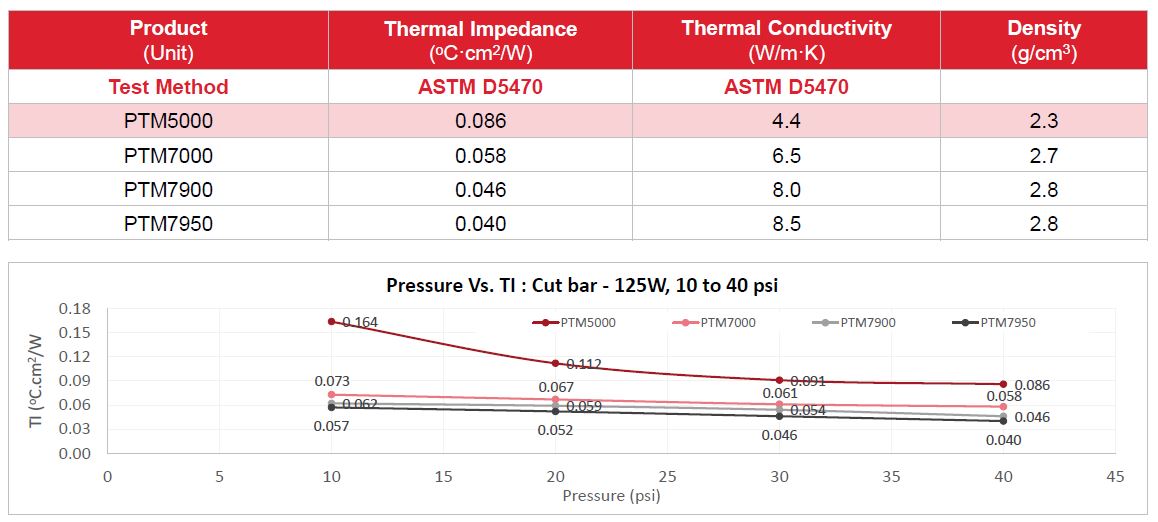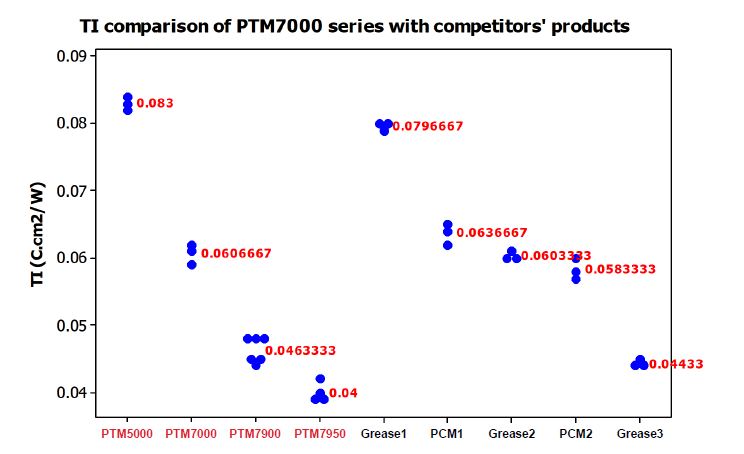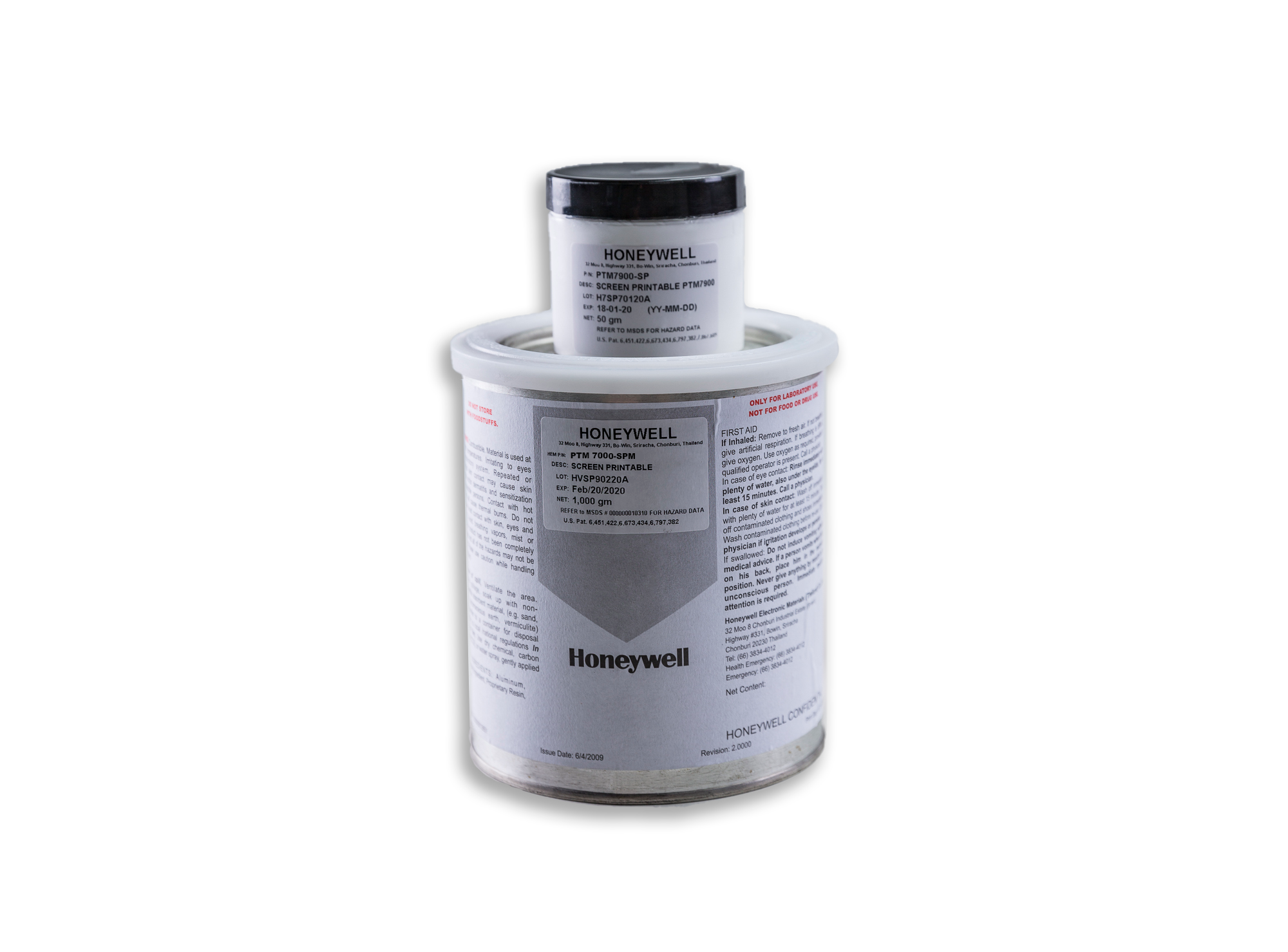PTM 7000-SPM | Phase Change Paste
- 0.06 Thermal Impedance
- 6.5 Thermal Conductivity
- Medium drying solvent
Product Description
PTM7000-SPM is identical to PTM7000-SP but with a medium drying solvent for processes that require longer drying time. This means that drying time is ±48 hours at room temperature and ±8minutes at 100°C. It is designed to minimize thermal resistance at interfaces and maintain extremely stable performance through reliability testing required for long product life applications. As with all Phase change materials, it has stable Thermal Impedance across accelerated aging tests and does not display bleed, pump or flow out. SPM-Medium drying solvents are nice to have but SP versions should work just as well since the initial drying up issues are usually cleared up quickly after the printing equipment setup has been optimised.
PTM7000-SPM has a Thermal conductivity of 6.5 (W/m·K) depending on the bondline thickness and is based on a robust polymer PCM structure that exhibits excellent wetting properties during typical operating temperature ranges, resulting in very low surface contact resistance. This proprietary material provides superior reliability and maintains low thermal impedance (0.06) , making it desirable for high-performance integrated circuit devices. Its latent heat of fusion is 0.62 J/g while its Specific heat capacity is 0.96 J/g.
Solvent Drying time:
- 48hours @ 23°C
- 8mins @ 100°C
Technical Specifications
| General Properties | |
| Specific Gravity Specific Gravity Specific gravity (SG) is the ratio of the density of a substance to the density of a reference substance; equivalently, it is the ratio of the mass of a substance to the mass of a reference substance for the same given volume. For liquids, the reference substance is almost always water (1), while for gases, it is air (1.18) at room temperature. Specific gravity is unitless. | 2.3 |
| Thickness range | 0.20 - 1.00 mm |
| Thermal Properties | |
| Thermal Conductivity Thermal Conductivity Thermal conductivity describes the ability of a material to conduct heat. It is required by power packages in order to dissipate heat and maintain stable electrical performance. Thermal conductivity units are [W/(m K)] in the SI system and [Btu/(hr ft °F)] in the Imperial system. | 6.5 W/m.K |
| Thermal Impedance | 0.06 °C·cm²/W |
| Electrical Properties | |
| Volume Resistivity Volume Resistivity Volume resistivity, also called volume resistance, bulk resistance or bulk resistivity is a thickness dependent measurement of the resistivity of a material perpendicular to the plane of the surface. | 2.1x1014 Ohms⋅cm |
| Physical Properties | |
| Viscosity Viscosity Viscosity is a measurement of a fluid’s resistance to flow. Viscosity is commonly measured in centiPoise (cP). One cP is defined as the viscosity of water and all other viscosities are derived from this base. MPa is another common unit with a 1:1 conversion to cP. A product like honey would have a much higher viscosity -around 10,000 cPs- compared to water. As a result, honey would flow much slower out of a tipped glass than water would. The viscosity of a material can be decreased with an increase in temperature in order to better suit an application | 120,000 mPa.s |
Additional Information
When choosing a printable paste it is important to understand the process parameters and limitations.
That's why we ask, when you contact us, to include the following information:
- What is your print thickness?
- How long is your printing time and working window?
- What is your drying step after printing?
- Temperature (Room temperature or something else?)
- Time
- Do you have any viscosity limitations in the printing process?

PTM7XXX Series - Pressure vs Thermal Impedance

PTM7XXX Series vs Competition comparison (lower is better)
What is shelf-life and the shelf-life of the PTM7000-SPM?
Shelf-life refers to the amount of time the material can be kept when stored under the recommended storage conditions. The shelf-life of the PTM7000-SPM is 12 months when kept below 25°C and with less than 20% relative humidity (RH).
How is the material prepared prior to use?
If the material is supplied in 280cc cartridges, then the PTM7000-SPM can be dispensed directly onto the stencil. If the PTM7000-SPM is supplied in 1kg can, then it is best to mix or roll the material prior to each use. "Rolling" involves simply having the material "self-mix" which the can is being rolled (for this there is standard "jar roller" equipment).
Which packaging, the 1kg can or the 280cc aluminum cartridge is best recommended to use?
This depends on how you plan to apply the material. If you plan to dispense from a cartridge (hardly anyone dispenses) using a nozzle, then a cartridge is recommended. Also, if you plan to do much smaller batch sizes (ie less then 1kg at a time), then 280cc cartridges are better because you will lose less material per use. Printing, however, is a high throughput process. On any print cycle you will need at least 100cc of material on the stencil during printing which can coat many pieces per stroke. You will easily use up 280cc of material per shift during printing.
What is the potlife of the PTM7000-SPM?
Potlife (also referred to as work life) refers to the amount of time the material can be still be used after it has been opened. When kept in the 1kg cans, the potlife is 12 hours from the time the can is opened. When the lid is replaced and the can is closed again, you will have 48 hours to use the balance of the material. The remaining material should also be remixed (or re-rolled on a jar roller) prior to use.
Similarly, in the 280cc cartridge, the potlife is 24hrs if dispensed from the cartridge directly. If the cartridge is opened to add material to the printer and then closed again, the balance of the material should be used within 24-36 hours.
What is the thickness difference before and after drying?
It is typical to lose approx. 20% thickness due to solvent drying. For example, a 300µm (0.3mm) thickness stencil of wet PTM7000-SPM will result in 240µm (0.24mm) after drying. If the thickness loss is more than 20%, then the can was not stirred or rolled and it is indicative of mixing issues prior to dispensing them on the printing equipment.
PTM7000-SPM can dry completely when it is baked for 8 minutes at 100°C (based on 0.1 BLT). Thicker bondlines will require more time and temperature. For example for a 0.5mm sample fully dries after 15minutes at 140°C. It starts with ±15% shrinkage at 5 minutes and keeps on shrinking until it reaches ±21% at 15 minutes, after the solvent is fully dried.
What should I know about the Flash Point of this material?
The flashpoint of a solvent is the lowest possible temperature at which it can vaporize to form an ignitable vapor. Flashpoint is often confused with “autoignition temperature”, which is the temperature at which a solvent ignites without an ignition source. For SPM, the solvent content is under 10% of the formulation. The flashpoint of the solvent is more than 50℃ and its boil point is more than 180℃. Thus, the solvent steam at room temperature is relatively safe and has a very low risk of combustion. As long as there is no open fire in the oven and have a good ventilating system that can let solvent steam from the oven into the environment, the solvent in the material during the drying process will be very safe.
If your oven is not of the latest technology and you need to consider the flammable limits, the lower one is 0.6% and the upper one 6.0%



